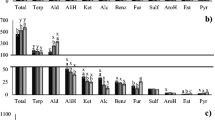Abstract
The aim of the study was to describe the thermal characteristics of poultry pates enriched with vegetable components in relation to their chemical composition and technological process. Two poultry pates from chicken liver, chicken or turkey meat with vegetables were developed. The thermal characteristics of the raw materials and the ready pates were examined by differential scanning calorimetry; fatty acid profiles were detected by gas chromatography analysis. The study investigated the effect of such factors as heating/cooling rate and matrix effect of other components (e.g., proteins) in the raw materials and in the pates. It was observed that the cooling rate has a considerable effect on melting/crystallization temperature, enthalpy, and height of peaks in the process of pates fat crystallization, as well as peak height and enthalpy in the melting process. The first peaks formed during the crystallization were characterized by high instability, demonstrated by various peak shapes. The rapid cooling led to lowering of the melting point, assigned to the presence of unstable α crystals. The slow cooling led to mainly stable β′ crystals. The fraction of unsaturated fatty acids present in the fat was important for both crystallization rate and melting points in the raw materials and in the products as well. This effect was stronger in the pate products because of the presence of diverse components such as proteins. The results obtained could be used for the evaluation of thermal stability of pate fatty acids and further optimization of the pate thermal treatment.







Similar content being viewed by others
References
Svenstrup G, Brüggemann D, Kristensen L, Risbo J, Skibsted LH. The influence of pretreatment on pork fat crystallization. Eur J Lipid Sci Technol. 2005;107(9):607–15.
Ghotra BS, Dyal SD, Narine SS. Lipid shortenings: a review. Food Res Int. 2002;35:1015–48.
Boistelle R. Fundamentals of nucleation and crystal growth. In: Sato K, Garti N, editors. Crystallization and polymorphism of fats and fatty acids. New York: Marcel Dekker Inc; 1988.
Walstra P. Secondary nucleation in triglyceride crystallization. Progr Colloid Polym Sci. 1998;108:4–8.
Relkin P, Ait-Taleb A, Sourdet S, et al. Thermal behavior of fat droplets as related to adsorbed milk proteins in complex food emulsions. A DSC study. J Am Oil Chem Soc. 2003;. https://doi.org/10.1007/s11746-003-0766-1.
Shukat R, Bourgaux C, Relkin P. Crystallisation behaviour of palm oil nanoemulsions carrying vitamin E: dSC and synchrotron X-ray scattering studies. J Therm Anal Calorim. 2011;108(1):153–61.
Kalnin D, et al. Monitoring fat crystallization in aerated food emulsions by combined DSC and time-resolved synchrotron X-ray diffraction. Food Res Int. 2002;35(10):927–34.
Relkin P, Sourdet S, Fosseux PY. Fat crystallization in complex food emulsions: effects of adsorbed milk proteins and of a whipping process. J Therm Anal Calorim. 2003;71(1):187–95.
International Organization for Standardization (ISO). Animal and vegetable fats and oils—Gas chromatography of fatty acid methyl esters—Part 2: Preparation of methyl esters of fatty acids. (Standard No. 12966–2:2017). 2017; https://www.iso.org/standard/72142.html.
International Organization for Standardization (ISO). Animal and vegetable fats and oils—Gas chromatography of fatty acid methyl esters—Part 1: Guidelines on modern gas chromatography of fatty acid methyl esters. (Standard No. 12966–1:2014). 2014; https://www.iso.org/standard/52294.html.
Litwinenko JW, Rojas AM, Gerschenson LN, Marangoni AG. Relationship between crystallization behavior, microstructure, and mechanical properties in a palm oil-based shortening. J Am Oil Chem Soc. 2002;79:647–54.
Kang MJ, Shin MS, Park JN, Lee SS. The effects of polyunsaturated: saturated fatty acids ratios and peroxidisability index values of dietary fats on serum lipid profiles and hepatic enzyme activities in rats. Br J Nutr. 2005;94:526–32.
deMan L, deMan JM, Blackman B. Physical and textural characteristics of some North American shortenings. J Am Oil Chem Soc. 1991;68:63–9.
Hodge SM, Rousseau D. Flocculation and coalescence in water-in-oil emulsions stabilized by paraffin wax crystals. Food Res Int. 2003;36:695–702.
Decca MB, Perduca M, Monaco HL, Montich GG. Conformational changes of chicken liver bile acid-binding protein bound to anionic lipid membrane are coupled to the lipid phase transitions. BBA Biomembr. 2007;1768(6):1583–91.
Elodie A, Relkin P, Pina M, Collignan A. Characterisation of chicken fat dry fractionation at the pilot scale. Eur J Lipid Sci Technol. 2004;106(9):591–8.
Galluzzo SJ, Regenstein JM. Role of chicken breast muscle proteins in meat emulsion formation: myosin, actin and synthetic actomyosin. J Food Sci. 1978;43(6):1761–5.
Lopez C, Bourgaux C, Lesieur P, Bernadou S, Keller G, Ollivon M. Thermal and structural behavior of milk fat. 3. Influence of cooling rate and droplet size on cream crystallization. J Colloid Int Sci. 2002;254:64–78.
Vanapalli SA, Palanuwech J, Coupland JN. Stability of emulsions to dispersed phase crystallization: effect of oil type, dispersed phase volume fraction, and cooling rate. Colloids Surf A Physicochem Eng Asp. 2002;204:227–37.
Walstra P. Crystallization. In: Walstra P, editor. Physical chemistry of foods. New York: Marcel Dekker Inc; 2003. p. 583–649.
Acknowledgements
The study was supported by the Project No. HTAI129 (Formulation and Design of Food-products and Beverages for Preventive Nutrition) of Agricultural Academy of Bulgaria.
Author information
Authors and Affiliations
Corresponding author
Rights and permissions
About this article
Cite this article
Marudova, M., Momchilova, M., Antova, G. et al. Investigation of fatty acid thermal transitions and stability in poultry pates enriched with vegetable components. J Therm Anal Calorim 133, 539–547 (2018). https://doi.org/10.1007/s10973-017-6841-z
Received:
Accepted:
Published:
Issue Date:
DOI: https://doi.org/10.1007/s10973-017-6841-z




